The citizens of Corfu, influenced as they were by the Venetians,
have inherited their love for music, the theatre and the fine arts.
Even nowadays, the visitor is able to discern, especially among the
elders of Corfu, a politeness, which possibly stems from the long-lasting
sovereignty of the Venetians. It is the only city in Greece that
boasts seven philharmonic orchestras, a conservatoire, two choirs
and four theatres; it is there that the Department of Musical Studies
was established at the Ionian University.
Musical education in Corfu
Homer speaks of a great Corfian musician, the blind citharoedus Demodocus,
whose singing made Homer shed tears at the court of king Alcinous.
But since the era of the bards, who sang of the triumphs of mythical
heroes, until the 19th century, Corfu has a long history, the greater
part of which we know very little. The particular economical prosperity
during the 6th century B.C. favoured the cultivation of the arts
and cultural events. As professor Th. Pappas states, during the 2nd
century B.C., theatrical and musical competitions were performed
in Corfu, with the aid of sponsors.
During the Byzantine era though, this musical tradition came to a
halt. The advent of Christianity also meant the abandonment of anything
that was connected to the ancient Greek religion. Theocratic Byzantium
and the Eastern Church severely persecuted instrumental music. This
resulted in the disappearance of polyphonic music in the eastern
part of the Mediterranean in favour of the eastern monophony. It
is in this context that we can fully comprehend Saint John Chrysostom’s
rage against instrumental music, which has left its mark upon Greek
music.
Corfu’s influence by Constantinople gradually ceases after 1204.
During foreign occupation and up until the unification of Corfu with
Greece, western conquerors influenced greatly local artistis. In
this period the Corfian musical tradition will merge with those of
the Greek refugees and the northern Italian settlers, the western
polyphonic music and, later, with belcanto. This resulted in the
bloom, not only of popular songs and the “serenade” (with a profound
western influence), but especially of a musical lifestyle which would
be charactyeristic of Ionian music.
Ecclesiastical music could not have avoided this influence although
this did not mean a simultaneous detachment from the eastern orthodox
ecclesiastic doctrine. During the Renaissance, Corfu, being right
on the way connecting Venice with Crete, undoubtedly participates
in the new literary and musical trends, but is still in the shadow
of the great auteurs of the time: Cornaros, Theotocopoulos and Leodarites.
When, in 1669, the Cretan refugees found shelter in Corfu and the
rest of the Ionian islands, which were occupied by the Venetians,
they also brought along with them their genuine musical tradition.
Thus, the psalmody of the Ionian islands with Byzantine melodies
and triple impromptu escort is, even today, called “cretan music”.
The making, in 1690, of San Giacomo was decisive for the musical
performances and the further growth of westernish musical tradition
in Corfu. It started as a lodge of the noble and was transformed
into a theatre in 1720. In 1733 it started accommodating opera performances
and became the oldest and most prominent musical birthplace of the
Balkans and eastern Mediterranean, the benefits of which, Corfu,
against all odds, enjoys until today. The great Musical School of
the Ionian islands -with composers like Mantzaros, Ksindas, Liverales,
Labelet and Samaras- was, during the 19th and at the beginning of
the 20th century, the peak of this long-lasting musical tradition.
Corfu and the rest of the Ionian islands, gave us not only the first
Greek composers, but also the first musical pedagogues and the first
professional musical performers. In that time the people of Corfu
became lovers of the opera and the lyric show and attained a high
artistic standard. New venues (Municipal Theatre) are built to accommodate
the constantly growing theatrical audiences.
The philharmonic orchestras of Corfu which started to be established
from 1840, are worthy on-carriers of the local musical tradition.
The numerous musical bodies which still exist on the island (philharmonic
orchestras, choirs, conservatoires, the Municipal symphony orchestra
of Corfu and a chamber music group) keep up the musical tradition
of Corfu.
The foundation of both the High school of Music and the Department
of Musical Studies at the Ionian University has actually created
a musical tradition for Corfu; it is this tradition that has led
to the advent of numerous modern Greek composers.
Finally, the creation of many Artistic Societies and Unions, which
enhance the present status musical tradition and set a standard for
the future, creates a new perspective for Greek musical history.
[Original text in Greek taken from the web site of the Municipality
Corfu:
http://www.corfu.gr/en.htm .]
Opera in Corfu during the Venetian period
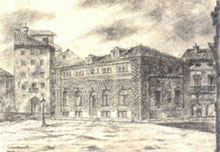 |
| San Giacomo theatre when it was first built |
The San Giacomo theatre of Corfu is not just the place where opera was
performed for the first time within the region of the Balkans and the eastern
Mediterranean. It is also the laboratory where the lyric theatre was cultivated
in Corfu, the temple where the musical initiation of the Corfians took
place, the venue where the western melodies mingled with the eastern ones.
It is the birthplace of the Ionian Musical Culture and an inexhaustible
source from which a plethora of artistic events streamed. It has never
actually ceased its operation, even in the difficult days of the Corfians.
The contribution of the San Giacomo theatre to the modern Greek culture
has been more than significant.
Birth of the opera
The opera was set forth thanks to the ambition of the artistic Florentine
count Giovanni Maria de Bardi and his humanistic companions to revive
ancient Greek tragedy. Hence, in 1597, the bucolic romance Dafnis
was performed for the first time. The libretto was written by Ottavio
Rinuccini and the music was composed by Jacopo Peri and Jacopo Corsi.
It was an imitation of the ancient Greek tragedy, which was called
‘dramma per musica’ or ‘opera in musica’. This effort was met with
great success and soon the opera extended to the rest of Italy,
and approximately a century later it had spread out in Kings’ courts
and the main urban centres of Europe; it was actually special stages
that would accommodate particularly melodramatic performances.
In time, there were four kinds of this opera that stood out:
1. Opera seria: Serious, not necessarily tragic
2. Operasemiseria: With intermediate comic elements
3. Opera buffa: With a light or comic plot
4. Grand opera: With a tragic plot and high quality standards
Opera in Venice
Claudio Monteverdi (1613-1643), the “father of the opera”, who lived
in Venice, assured an enviable European lead in the consolidation
and progress of the lyric theatre for the city of the Doges. The
first public stage, built especially to accommodate opera performances,
was constructed in 1637 in Venice (Teatro San Cassiano).
During the 17th century, Venice, having sixteen stages, was the centre
of the European opera; the Ionian Islands were part of the “Marine
State of Venice”. The musical initiation of the Ionian people begins
under the influence of the Venetian metropolis with the opera performances
at the San Giacomo theatre in 1733. That was 45 years before the
construction of Teatro alla Scala in Milan (1778).
The construction of San Giacomo
The architectural masterpiece, which today houses the office of the
Mayor of Corfu and some other Municipal departments, was built in
the 17th century. The noble decided to establish a cenacle (a lodge)
where its members could gather and exchange views and, at the same
time, entertain themselves according to the paradigm of the metropolis
and the rest of the Italian cities of the Renaissance. Thus, in 1660,
a proposal was introduced for a lodge (Loggia) to be constructed.
It was immediately approved by the General Proveditor of the Sea,
Antonio Damosto, but due to lack of resources, its construction begun
in 1690, since the whole matter was undertaken by a special steward,
Knight Konstantinos Kokines.
But Corfu is already drawing the increasing attention of Venice.
After the fall of Handakas (1669), Corfu houses the entire eastern
administration and the numerous crews of Her Highness’ fleet. Greater
mobility is noticed after the saving of the city from the Turkish
fleet (siege in 1716). The General Intendant of the East, Andrea
Corner, takes initiative and, in 1720, he converts the lodge into
a theatre for the entertainment of the officers of the fleet. He
delegates the administration of the building to the military authorities.
The theatre was named «Nobile Teatro di San Giacomo», after the Metropolis
of the Catholics (Duomo) which was next to it and commemorated Saint
Jacob.
Operation of the theatre
The close connection of Corfu to the Venetian culture contributed
to San Giacomo’s operating within European standards. The performances
began with particular circumstance in the presence of the officers
of Venice and the Corfian authorities. The general command was of
the General Intendant of the Sea, that is the supreme commandant
of the islands. He was responsible for the theatre and the performances
while he himself entertained the other authorities during the intermissions.
From the first years of operation, the theatre’s repertoire intended
to meet the taste of the audience, the need for entertainment and
also the need for creating a place for social association and affirmation
of the social status of the audience. The conditions under which
the theatre operated were guaranteed by the allocation of all theatre
tasks to an impresario, who created a performances schedule and
submitted it for approval to the Theatre Board. During the English
occupation the jurisdiction of San Giacomo theatre was assigned
to a three-member committee, the supervision of which was exercised
by the Eparch (the Mayor) and to which the impresario reported,
after having fulfilled all the terms of the agreement. The commission
funded the performances. The people of the Ionian Islands believed
that the theatre, like public schools, was sine qua non obligation
of the state. The method of all0ocating funds from the Ionian State
directly to the Theatre was discontinued by the “indigent and ignorant,
and therefore indifferent to cultural matters” Greek state when,
in 1864, the Ionian Islands were united with Greece. The local Corfian
music lovers who could afford to fill San Giacomo even with an over-priced
ticket changed this. Moreover, the decision, in 1885, of the Corfian
Town Council for a new, larger and more integral theatre constitutes
a proof for the undiminished operamania of the people of Corfu.
San Giacomo theatre
This Renaissance style theatre was entirely built out of carven stone.
The architect of the patterns is still unknown. Externally it was
lavishly decorated with arches and baroque sculptures which made
it a sublime ornament of the city. The entrance to the theatre was
its last arch, which was especially set, while the orchestra was
at the same height as the entrance and people came in from the back
seats. Two staircases at the ends of the eastern side led to the
boxes and the gallery. The stage was built on the western side while
its overall capacity of spectators was approximately 350 people.
The orchestra had 12 rows of seats and above it there were three
rows of boxes (23 on the whole) which could be rent by season only
to the noble, but later to the rich citizens as well. Above the boxes
was the gallery, which was filled, in the beginning, with rich townees
and later on with “every social element”.
The curtain of San Giacomo
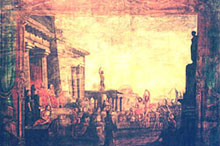
The
curtain of San Giacomo was a true gem. Created by Giovanni
Buzatto or, according to others, by Napoleone Genovesi the
7,20 x 4,50 metres work of exceptional art bore an image of
Ulysses being welcomed on the island of the Phaeacians. The
artist, in order to depict the faces of the Phaeacians, drew
his inspiration from the actors, musicians and technicians
of the theatre. This particular curtain decorated the New Municipal
Theatre as well. It was saved by the great disaster of 1943
by chance. Today it lies in the Municipal Theatre of the city.

Another interesting detail of San Giacomo theatre was Portantina.
It was a gold-filled buggy, with no wheels and a velvet seat
inside, which carried the prima donna of every performance
to and from the theatre. The prima donna was a great diva of
the time, an adorable individual for the people of Corfu; the
latter expressed their admiration to “the first treble” in
any possible way. Today, Portantina, a rare heirloom of San
Giacomo, is also in the Municipal Theatre.
San Giacomo and its annex
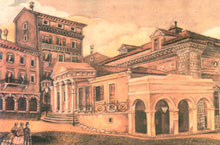 |
| Ôï èÝáôñï San Giacomo ìå ôçí ðñïóèÞêç |
In 1832, due to the lively interest of the Corfian people for the lyric
theatre, the need emerged for the reconstruction and improvement of the
interior and the parallel expansion of the exterior with a new annex, the
so-called Atzounda. With Commissioner Adam’s special fund, an orchestra
was made with 200 seats and 24 boxes (15 central and 16 unipartite ones)
and the gallery was abolished. The square hall was changed into a semicircular
one. On the outer side and in front of the central part of the facade,
there was a new entrance built, with a classicist temple-shaped prostyle
of a Toscan-Dorian order. Several functional rooms like offices, a foyer,
a cloakroom and a small lounge, place for conversation and entertainment,
were housed in the annex (Atzounda). These additions were removed in 1902
when the theatre was turned into the Town Hall, designed by engineer Serpieres.
Originally, entrance to women was denied. Later, married women were allowed
with the obligation to watch the performances from boxes covered with gratings
(LOGES GRILLEES). In the course of time the regulation changed and women
could watch the performances wearing masks, thus assuring incognito. Finally,
this measure was set aside and everybody was free to enter the theatre.
Ôhe incident with Stamates Voulgares
San Giacomo theatre got almost burnt during the Russian-Turkish
siege (1799), when a projectile actually landed (but did not explode)
at the feet of a young Corfian who happened to be standing next
to the theatre at that moment. The young man, Stamates Voulgares,
managed to defuse the projectile, literally saving not only San
Giacomo but also a French military squad that was passing by and
was carrying heavy weaponry and ammunition. The French, willing
to honour the young man’s heroism, enlisted him in their guard and
when they left the young man followed them showing great performance
at mechanics and painting. During Kapodistria’s rule, he became
the first city planner of liberated Greece.
Performances at San Giacomo
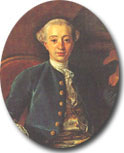 |
| Giacomo Casanova |
| |
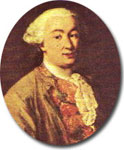 |
| Carlo Goldoni |
From the beginning until 1733 only tragedies and comedies were performed
at San Giacomo. But that year, impresario Carlo Grassi suggested a melodrama.
His suggestion was accepted and since then the lyric theatre became a second
nature not only for the Corfians, but also for all the people of the Ionian
Islands. It played a significant part in the culture, the qualitative entertainment
of the residents and the struggle for unification. Carlo Grassi was living
in Corfu, at least until 1740, organising performances, whereas famous
Giacomo Casanova’s memoir gives evidence that Casanova himself was impresario
in Corfu in 1745, when he brought a vagrant theatre company, Comedia dell'arte
from Otranto, Italy to the island.
The performances began in October with prose theatre companies. In Christmas
the plays were melodramas, while at carnival time light opera theatre companies
came, to be followed by theatre companies again. Later, during carnival
time, fancy dress balls (Kavalkines) were established.
Italian theatre companies came to Corfu for the duration of the 18th and
the 19th century. The theatre was always open, even at times of war or
siege. What happened during the four-month siege of Corfu by the Russian-Turks
in 1798-1799 is characteristic: the opera performances did not stop and,
because of the events around them, the Italian theatre company kept on
performing twice a week. The entrance was free to both citizens and soldiers
so that their spirits would be raised.
In parallel to the opera performances at San Giacomo, there were also prose
performances. Based on historical sources we know that theatrical performances
were held in Corfu in 1685 in order to honour F. Morosini from the Peloponnese.
Many a vagrant theatre companies performed Comedia dell’arte and plays
written by Carlo Goldoni, whose comedies the Corfians preferred. Furthermore,
some amateur Corfians performed plays during the 18th century. A noble
young man, George Rikes, and his companions performed a drama in 1770.
In 1817, prose theatre was performed for the first time in the Greek language
at San Giacomo. That night, the English commissioner was present, Thomas
Maitland, who attended “Polyxena”, a tragedy in five acts by Iakovakes
Rizos-Neroulos. More performances in Greek language followed: plays in
translation written by famous authors like Alfieri, Metastasio, Voltaire,
Moliere and Racine. Many of these plays were performed by the students
of the Ionian Academy under the guidance of the great philhellene Lord
Guildford.
In those days the patriotic feeling of the Corfians was elevated, given
that it coincided with the struggle of the Greeks for liberation. Thus,
a lot of Ionian and Italian composers and dramatists were inspired by the
protagonists of 1821. Several plays were performed which enraptured the
Corfian audience who loved the theatre and played a leading part in the
disillusionment of the Greek conscience that led to the unification of
the Ionian Islands in 1864. However, after the unification, timely episodes
like the Cretan uprisings kept on supplying the local authors with themes.
They put on plays and sent all box-office revenues to the revolutionaries
for financial support.
San Giacomo has one more “lead” in the theatrical field. On February 9,
1833, a performance was given of The Laureate Wreath, written by S. Zabelios
and N. Nikolaidis. Two actresses were embraced among the actors, Akrivoula
Stavrou and Ekaterine Kabatine. That was nine years before female performers
appeared in the Athenian stage.